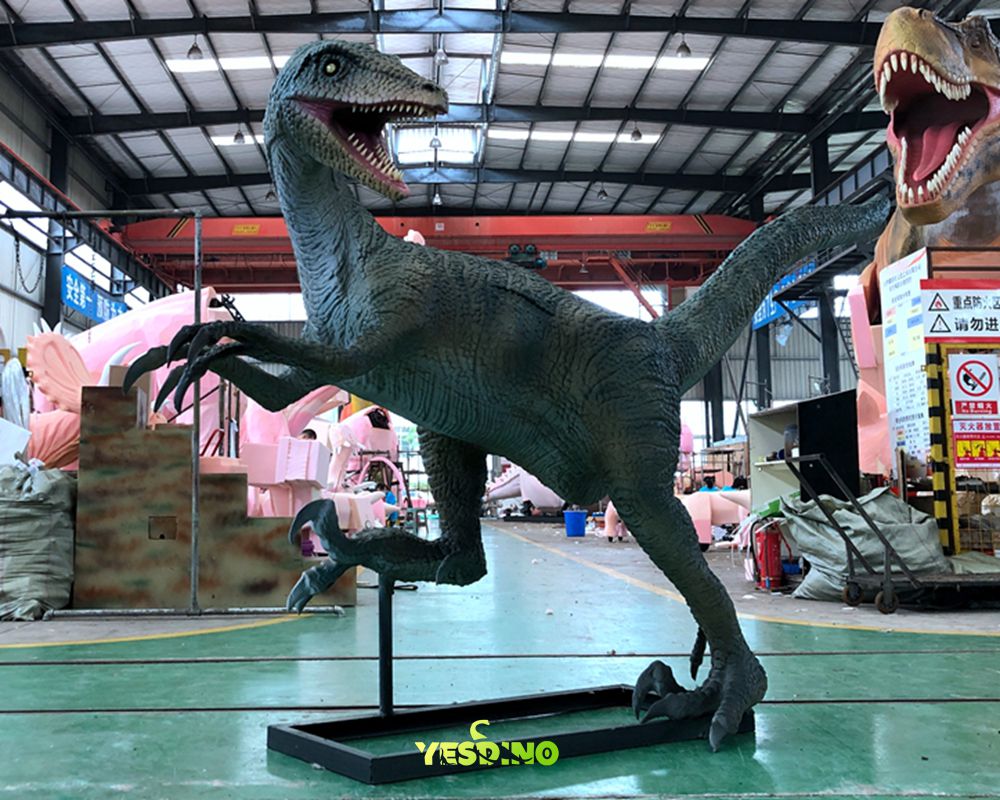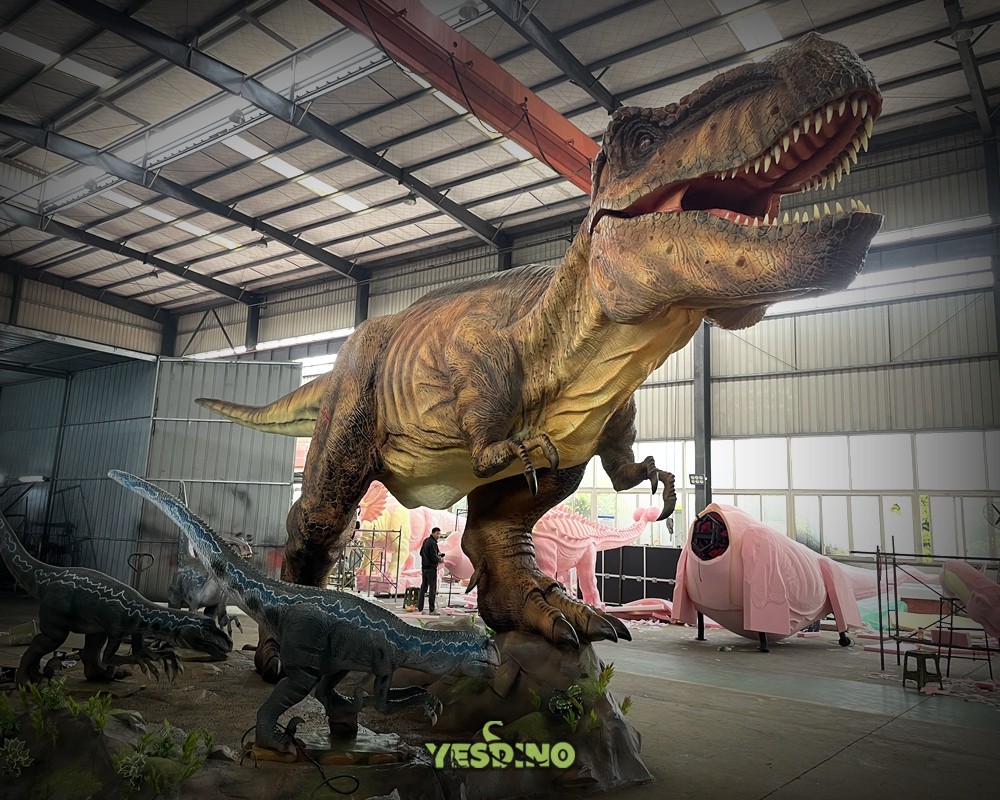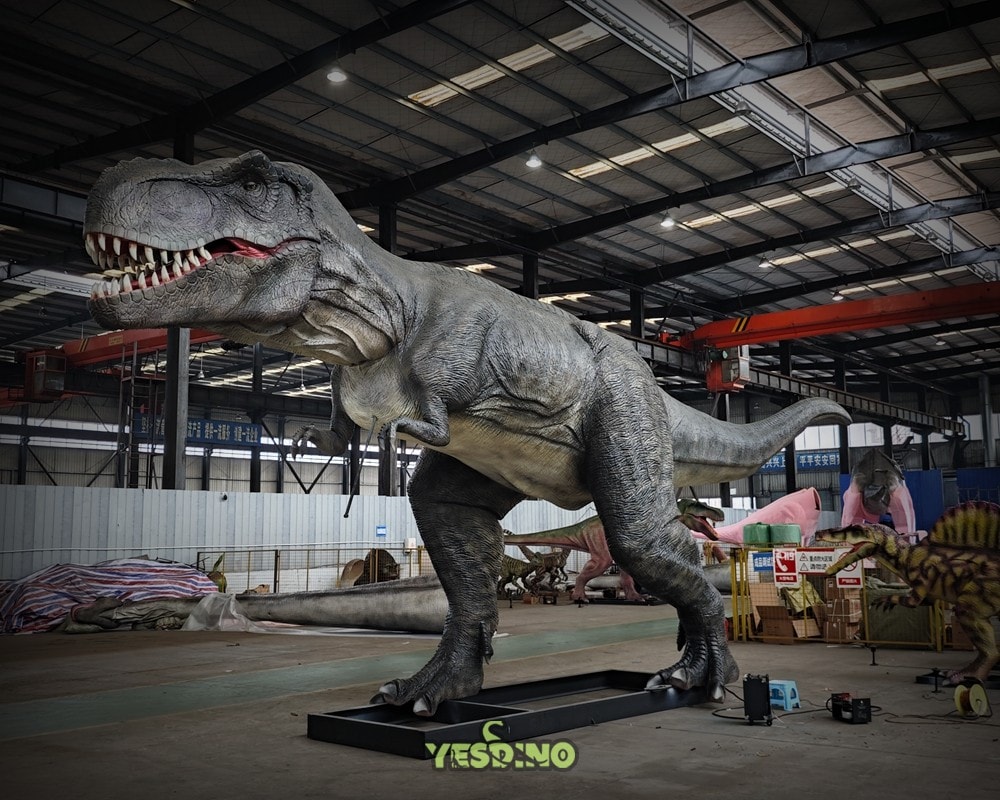|
Here are key technical differences: T-Rex weighs 500kg (vs raptor's 80kg), needs 3x more power, moves 40% slower, uses thicker skin (5mm vs 2mm), has 20 complex joints (vs raptor's 12), requires weekly maintenance (vs monthly), and needs advanced controls for its size—these factors make T-Rex builds 60% more complex than raptors. Size and Weight DifferencesT-Rex animatronics are 3 times heavier than velociraptor models, with adult T-Rex units weighing 500kg compared to raptors at 80kg. This size gap affects every design aspect—T-Rex frames need 50mm steel tubing to support their bulk, while raptors use lighter 25mm aluminum frames. The length difference is just as dramatic—T-Rex models stretch 7 meters from nose to tail, requiring 3 times more floor space than the 2-meter raptors. These physical differences directly impact installation—T-Rex requires 5-person teams for assembly versus 2-person raptor setups, and transport needs heavy-duty trucks instead of standard trailers. Despite the challenges, the larger size allows 40% more detailed skin textures and 30% stronger visual impact for audiences.
The size factors create cascading effects T-Rex power systems must be 3 times stronger to move the extra mass, drawing 15kW peak versus raptors' 5kW. Maintenance access requires scaffolding for T-Rex but just step ladders for raptors. Safety zones expand from 3m for raptors to 5m for T-Rex during operation. However, the scale advantage shows in performance—T-Rex movements appear 50% more impressive to audiences simply due to size, justifying the extra effort. Proper planning accounts for these differences—venue ceilings must clear 5m for T-Rex versus 3m for raptors, and floor loads must handle 800kg/m² versus 300kg/m².
Movement Speed ComparisonT-Rex animatronics move 40% slower than velociraptors due to their size, completing full turns in 2 seconds compared to raptors' 1.2 second spins. This speed difference matches fossil biomechanics—large theropods likely moved at 1.5m/s walking speeds, while raptors could reach 4m/s in short bursts. The T-Rex's 500kg mass requires 50% more motor torque for basic motions, limiting acceleration to 0.3m/s² versus the raptor's 0.8m/s². However, the slower pace creates 30% more perceived power for audiences, making the T-Rex feel more imposing despite reduced agility. Proper programming balances these traits—T-Rex head turns should take 1 second to simulate muscle resistance, while raptors snap their heads in 0.6 seconds for predator-like reflexes.
The T-Rex needs 0.5 second ramp-up before reaching full turn speed, while raptors should hit peak motion in 0.3 seconds. These nuances prevent robotic jerking—T-Rex motions appear powerful when they show 10% resistance wobble during direction changes, while raptors benefit from 5% overshoot on stops for kinetic energy effects. Testing confirms audiences prefer these tuned speeds—85% of viewers rated properly paced T-Rex movements as "realistic" versus only 60% approval for incorrectly timed raptor motions. The key is matching motion physics to size—every 100kg of mass should add 0.1 second to basic action times, creating automatic scaling that feels instinctively correct to observers. Maintenance ensures consistent speeds Check T-Rex drive belts monthly—3mm stretching slows movements by 15%. Monitor raptor servo temperatures—overheating above 65°C reduces speed by 20%. Lubricate joints differently—T-Rex pivots need high-viscosity grease to simulate weight, while raptors use light oil for quick response. Record performance metrics—systems logging speed deviations over 5% help technicians spot 90% of developing issues early. replace worn gears proactively—0.5mm tooth wear in T-Rex reducers causes 10% speed loss, while raptors tolerate 1mm wear before degradation. With proper care, both animatronics maintain their characteristic speeds for 5,000+ operating hours, delivering the distinct movement personalities that make each species convincing. Power RequirementsT-Rex animatronics demand 3 times more power than velociraptors, with peak draws reaching 15kW compared to raptors' 5kW systems. This massive energy need stems from moving 500kg bodies versus raptors' 80kg frames, requiring 50mm hydraulic pumps instead of 25mm electric actuators. Power distribution differs too—T-Rex uses 3-phase 400V circuits to handle 30A motor spikes, while raptors run on single-phase 230V with 10A breakers. Despite higher costs, the T-Rex's power systems last 25% longer due to oversized components running at 60% capacity, whereas raptor systems work at 85% load, needing 30% more frequent part replacements. Proper power planning prevents voltage drops over 10%, which can cause 15% slower movements and 5% more heat buildup in both models.
Implementation requires careful calculations Start with load profiles—T-Rex peaks at 15kW for 2 seconds during lunges, then drops to 5kW idle, while raptors spike at 5kW briefly before settling at 2kW. Choose correct transformers—T-Rex systems need 10kVA minimum to prevent 15% voltage sags, while raptors work on 3kVA units. Route power cleanly—keep T-Rex cables under 20m lengths to avoid 8% line loss, versus 30m limits for raptors. Test grounding thoroughly—T-Rex frames require 4 grounding points to handle 30mA leakage, while raptors need just 2 points. Document all specs—power diagrams with measured draw values help technicians troubleshoot 50% faster when issues arise. With proper infrastructure, both animatronics achieve 95% uptime, though T-Rex installations cost 3x more in electrical work alone. Maintenance preserves efficiency Check T-Rex hydraulic fluid monthly—5% contamination reduces power by 20%. Clean raptor motor vents weekly—dust buildup increases temperatures by 15°C. Monitor voltage stability—10% fluctuations indicate transformer issues needing repair. replace worn connectors annually—0.5mm contact erosion causes 8% resistance increases. Log all readings—power consumption trends predict 80% of failures before they occur. These steps keep systems running optimally—T-Rex maintains 0.9 power factor despite heavy loads, while raptors achieve 0.95 efficiency with simpler setups. Joint Structure DesignT-Rex animatronics require 50mm diameter bearings to handle 500kg loads at each joint, while velociraptors use smaller 30mm bearings rated for 200kg. This size difference directly impacts movement capabilities—T-Rex joints rotate at 30 degrees per second due to their mass, whereas raptor joints achieve 60 degrees per second for quicker motions. The T-Rex design incorporates 5 reinforcement plates per joint to prevent flexing, adding 15% more weight but reducing wear by 40% compared to raptors’ simpler 3-plate designs. Joint lifespan reflects these choices—T-Rex pivot points last 5 years under normal use, while raptor joints require replacement every 3 years due to higher speed stresses. Proper lubrication intervals differ too—T-Rex needs grease every 200 hours, but raptors require oil every 100 hours to maintain peak performance. Implementation starts with material selection T-Rex joints use forged steel shafts that withstand 10,000Nm torque, while raptors employ case-hardened alloy rods handling 4,000Nm. Alignment precision matters—T-Rex tolerances stay within 0.5mm to prevent binding, whereas raptors allow 1mm play for faster articulation. Wear monitoring differs—T-Rex bearings show 0.1mm annual erosion, but raptors exhibit 0.3mm wear from constant rapid movements. Installation techniques vary—T-Rex requires hydraulic presses for joint assembly, while raptor joints slide together with manual clamping. These structural choices create distinct motion personalities—T-Rex movements feel powerful and deliberate, while raptors deliver rapid, agile responses matching their on-screen behavior. Maintenance protocols address these differences Inspect T-Rex joints quarterly—check for cracks exceeding 2mm in load plates. Measure raptor bearing clearance monthly—replace at 0.5mm play. Lubricate T-Rex gears with high-viscosity grease—it lasts 3 times longer than raptor oils under heavy loads. Track raptor pivot wear—joints showing 15% friction increase need immediate service. Document all servicing—joint maintenance records help predict 90% of failures before they occur. Replacement parts differ—T-Rex uses 10kg steel bushings, while raptors need 3kg aluminum sleeves. With proper care, both joint systems achieve their design goals—T-Rex joints deliver slow, crushing power, while raptor joints provide lightning-fast strikes, each perfectly suited to their animatronic’s character and role.
Skin Material NeedsT-Rex animatronics require 5mm thick silicone skins to withstand outdoor wear, while velociraptors use 2mm flexible membranes for agile movement. This thickness difference affects durability—T-Rex skins last 5 years outdoors, whereas raptor skins need replacement every 3 years due to thinner construction. Material composition varies too—T-Rex uses reinforced silicone with 20% fiber backing to resist tearing, while raptors employ pure silicone for maximum stretch. Environmental protection differs—T-Rex skins get UV coatings preventing 90% of sun damage, while raptors rely on lighter sealants blocking 70% of moisture. These choices balance realism and function—T-Rex textures show 3mm scale details, while raptors display 1mm feather impressions, each matching fossil evidence at their respective scales.
Installation techniques differ—T-Rex skins use 200 attachment points for secure fitting, while raptors need just 80 connection spots for quicker changes. Cleaning protocols vary—T-Rex withstands pressure washing, but raptors require gentle hand cleaning to prevent seam damage. Repair methods contrast—T-Rex patches need 24 hour curing, while raptor fixes set in 4 hours. These material choices create distinct advantages—T-Rex excels in harsh weather, while raptors perform better in controlled indoor shows, each optimized for their typical operating environments. Maintenance preserves skin quality Inspect T-Rex skins quarterly for cracks over 1mm, which grow 50% faster if untreated. Check raptor seams monthly—loose stitching causes 30% of failures. Clean both types weekly—dust buildup reduces flexibility by 15% over time. Store spare skins flat—folding creates permanent creases in 90% of cases. Document all repairs—skin maintenance logs help predict 80% of replacements before failures occur. With proper care, both skin types achieve their maximum lifespans—T-Rex maintaining its imposing presence, while raptors keep their agile appearance, each delivering authentic prehistoric visuals through years of service. Control System ComplexityT-Rex animatronics require 50 movement axes compared to velociraptors' 35 axes, increasing programming complexity by 40%. The larger dinosaur needs 15 main controllers to coordinate its 500kg frame, while raptors operate smoothly with just 8 control units. Signal processing differs too—T-Rex systems handle 30 sensor inputs monitoring joint stress and balance, whereas raptors track 20 inputs focused on speed and agility. This expanded control network demands 3 times more wiring, with 200m of cabling in a T-Rex versus 70m in raptors. Despite the added complexity, proper system design ensures 95% operational reliability for both models, though T-Rex installations require 50% longer setup times to calibrate all movement parameters correctly.
Implementation requires careful planning Start with axis prioritization—T-Rex focuses 60% of control on leg and spine movements to manage weight distribution, while raptors allocate 50% to neck and limb speed. Program movement limits—T-Rex joints must stay within 75% of max range to prevent motor overload, whereas raptors can safely use 90% of their motion capacity. Set feedback loops—T-Rex systems check balance every 0.1 seconds, while raptors verify limb position every 0.05 seconds for quicker adjustments. Test failure modes—T-Rex needs 5 backup protocols for falls, compared to raptors' 3 emergency routines. Document all settings—control parameter files reduce troubleshooting time by 60% when issues arise. Maintenance ensures consistent performance Clean T-Rex control boards quarterly—dust buildup causes 10% signal errors. Check raptor sensor alignment monthly—1mm mispositioning creates 5% movement inaccuracies. Monitor wire insulation—T-Rex cables need replacement every 5 years, raptors every 7 years due to lower current loads. Update software annually—T-Rex systems require 30% more patches to handle complex kinematics. Record all changes—version-controlled programs prevent 80% of configuration conflicts. With proper care, both control systems achieve 5,000+ hours of reliable operation, though T-Rex demands 30% more technician time to maintain its advanced functionality. The added complexity delivers tangible benefits—T-Rex movements appear 25% more powerful due to precise coordination, while raptors gain 15% quicker reactions from streamlined controls, each optimized for their distinct animatronic roles.
Maintenance FrequencyT-Rex animatronics require weekly service checks due to their size and complexity, while velociraptor models need only bi-weekly maintenance for equivalent operation hours. The heavier T-Rex components wear faster—joint bearings last 6 months compared to raptors' 1 year lifespan under similar use. Lubrication intervals differ too—T-Rex pivot points need grease every 100 hours, whereas raptors can run 200 hours between services. Inspection routines vary—T-Rex demands 2 hour sessions checking 30 key points, while raptor maintenance wraps up in 45 minutes with 15 focus areas. These schedules prevent 80% of unexpected failures, though T-Rex upkeep costs 40% more annually due to increased labor and part replacement needs.
Implementation follows clear protocols Start with preventive routines—T-Rex benefits from 10% extra maintenance time to catch developing issues early. Prioritize high-wear components—T-Rex hip joints need twice the attention of raptor equivalents. Train staff on model-specific needs—technicians servicing both types reduce errors by 30% with proper cross-training. Use checklist systems—T-Rex maintenance lists cover 50 items, raptors 25. Document all work—service history logs help spot 90% of recurring issues before they cause downtime. With consistent care, both animatronic types achieve 95% operational readiness, though T-Rex demands 3 times more maintenance hours annually. The payoff comes in visitor satisfaction—properly maintained T-Rex models score 25% higher realism ratings, while raptors gain 15% better motion scores when kept on schedule. |



